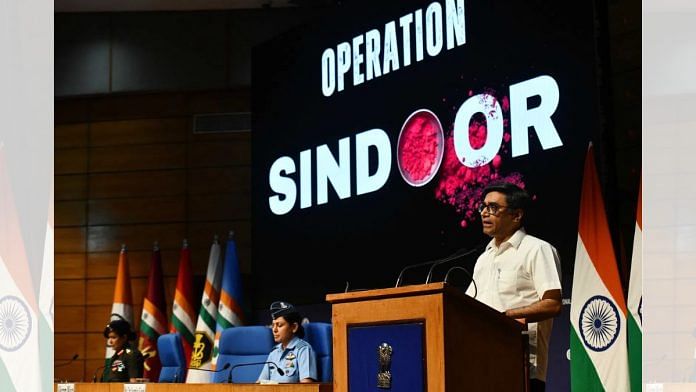Thank you dear subscribers, we are overwhelmed with your response.
Your Turn is a unique section from ThePrint featuring points of view from its subscribers. If you are a subscriber, have a point of view, please send it to us. If not, do subscribe here: https://theprint.in/
“Discretion is the better part of valour.” – Shakespeare, Henry IV, Part 1
Introduction
Operation Sindoor, India’s response to the Pahalgam terror attack of 22 April, has dramatically reignited overt hostilities between the two nuclear-armed neighbours. The four-day conflict and the sudden ceasefire that followed exposed the region’s enduring fragility. In its aftermath, both India and Pakistan sought to control the narrative—domestically and internationally. Yet, the underlying issues fueling these recurrent clashes remain unresolved. This article analyses the immediate and long-term implications of Operation Sindoor on regional stability and Indo-Pak relations.
Why the Pahalgam Attack?
Kashmir remains an unfinished agenda for Pakistan, essential for maintaining the Army’s grip over state affairs through the India-threat narrative. India’s stance has hardened, especially after the 1999 Kargil conflict, the 2001 Parliament attack, and notably post-2019 with the abrogation of Article 370. International focus had moved elsewhere—COVID-19, Ukraine, Gaza, and U.S. politics—allowing India to keep Kashmir off the global agenda. Rising tourism was reinforcing a perception of normalcy, countering Pakistan’s narrative.
Internally, Pakistan faces mounting challenges—waning Army popularity, political unrest, Baloch and TTP insurgencies. The Pahalgam attack, orchestrated at the behest of the Pakistan Army, was designed to redirect domestic attention, provoke India, and revive international focus on Kashmir.
India’s Response – Predictable Yet Calibrated
India’s military action was swift and expected—perhaps not in scale, but certainly in character. Operation Sindoor struck nine terrorist sites, including targets deep in Punjab province, marking India’s most extensive cross-border action since 1971. This escalation, more intense than the 2016 surgical strikes or the 2019 Balakot air strikes, aligned with PM Modi’s strongman image and public expectation.
Pakistan’s Reaction – Measured or Excessive?
Despite India’s framing of the strikes as counterterrorism measures, Pakistan viewed them as an act of war. It responded with drone and missile attacks on Indian military installations, followed by a large-scale operation—Bunyan al-Marsus—targeting sites across Punjab and J&K. India’s counter strikes on Pakistani airbases, notably, Nur Khan near Rawalpindi, raised concerns of nuclear escalation. While speculative, reports of a strike near Kirana Hills—suspected nuclear storage—may have been a turning point.
Pakistan’s escalation wasn’t due to miscalculation. Dr. C Christine Fair, professor at Georgetown University and a South Asia expert, calls the Pakistan Army an “Insurgent Army”. Amitabh Mattoo (Indian Express, May 22), says that the Pakistan military has framed itself as the custodian of its “ideological frontiers” and hence views Kashmir as existential. The fear of a failing nuclear state compels international actors to prevent such conflicts from spiralling, a factor Pakistan exploits.
Ceasefire – Expected or Enforced?
The ceasefire, declared after 88 hours, was first announced by Donald Trump via Truth Social. India claimed Pakistan sought cessation, mediated by the U.S. While welcomed overall, critics in India saw the ceasefire as premature. Speculation surrounds what triggered it—pressure from the U.S., strikes near sensitive military assets, or fear of nuclear escalation. In reality, both nations, despite aggressive posturing, were seeking an off-ramp.
A prolonged conventional war would have hurt both economies. For Pakistan, without external support (especially from China), it was unsustainable. For India, with greater resilience, the economic cost and investor uncertainty would still be significant. Discretion, indeed, was the better part of valour.
Did the Sides Achieve Their Objectives?
Pakistan, in the short term, met several goals—revived domestic Army support, re-spotlighted Kashmir internationally, and secured external involvement. However, its diplomatic and economic clout remains limited. Field Marshal Asim Munir’s promotion is symbolic, but strategic gains are tenuous.
India, on the other hand, demonstrated operational readiness, technological superiority, and a willingness to respond forcefully. The strikes showcased capability and intent, raising the cost for Pakistan’s proxy war strategy. Yet, while tactically successful, the operation did not change Pakistan’s long-term calculus. Terror leadership was moved before the strikes, and the terror infrastructure remains intact. India’s assertion that future attacks will be treated as acts of war also carries the risk of uncontrolled escalation.
What Next?
Ground realities are unlikely to change. Experts like Dr. C Christine Fair foresee continued Pakistani provocation under a nuclear umbrella, with limited conflict and episodic international mediation. India’s refusal to internationalize Kashmir has led to the absence of a sustained peace process. Pakistan’s playbook—proxy attacks, deniability, victimhood, and nuclear deterrence—remains unchanged.
Three future scenarios present themselves:
- A more belligerent Pakistan under a stronger Army leadership.
- A public-led political transformation in Pakistan, seeking peace for economic revival.
- India permitting limited external mediation—by the U.S., Saudi Arabia and UAE—to break the impasse.
The first appears most likely. The second is hopeful. The third, though difficult for India to accept, may offer a path forward. Are we willing to consider it?
These pieces are being published as they have been received – they have not been edited/fact-checked by ThePrint.


